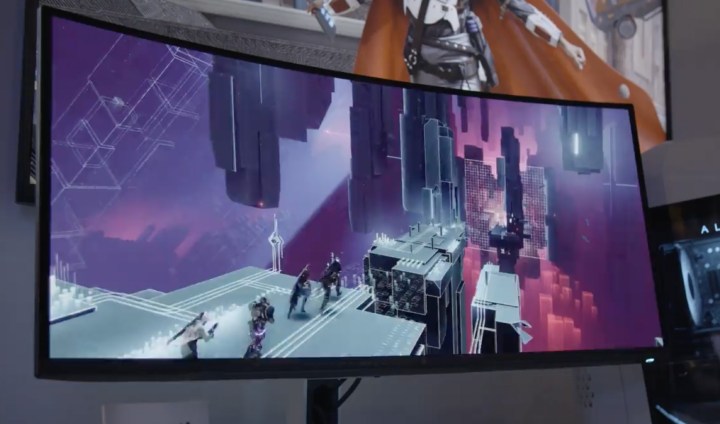Gaming monitors aren’t known for sporting the latest and greatest display tech. And that’s a shame. The new Alienware 34 QD-OLED, introduced at CES 2022, bucks that trend completely.
This new gaming monitors embraces the brand new QD-OLED (Quantum Dot OLED) technology from Samsung, which is just now coming to televisions this year. That fact alone left me impressed. But seeing it in person? That was its own marvelous experience.

| Alienware 34 QD-OLED | |
| Resolution | 3440 x 1440 (110 pixels per inch) |
| Screen size | 34.18 inches |
| Refresh rate | 175Hz (with DisplayPort) 100Hz (with HDMI) |
| Curve | 1800R |
| Aspect Ratio | 21:9 |
| Brightness | 250 cd/m2 (typical); 1,000 cd/m2 (peak) |
| Color gamut | 99.3% DCI-P3 / 149% sRGB |
| Color accuracy | Delta E<2 |
| HDR | DisplayHDR 400 True Black |
| Response Time | True 0.1ms gray-to-gray |
| Adaptive Sync | G-Sync Ultimate |
Quantum Dot technology, or QLED, has long been used by Samsung to compete against the rising popularity of OLED, especially in the LG television space. In the world of monitors and laptops, OLED and mini-LED are finally starting to gain a foothold — in some cases, even in products that aren’t exclusively high-end.
Hence, Samsung’s QD-OLED, a hybrid technology that supposedly combines the best of both worlds.

The Alienware 34 QD-OLED is a good example. In some ways, it’s a follow-up to Alienware’s last major experiment in panel technology, the Alienware OLED 55 Gaming Monitor. It wasn’t ultra-wide, nor was it curved — instead, hoping to sit on an entertainment system rather than a desk. Add in a price tag of $4,000, and you have yourself an extremely niche product.
That’s where the Alienware 34 QD-OLED attempts to do something entirely different. QD-OLED means you get the true blacks and infinite contrast of individually-lit pixels but enhanced through a Quantum Dot pixel layer.
The promise? The glory of OLED in a more familiar form factor at a more affordable price. And yes, even better image quality. I can’t validate that myself, but in my time checking it out, it certainly looked as vibrant as OLED to my naked eye.

Dell says the Quantum Dot pixel layer also “results in higher color uniformity, wider color coverage, and increased brightness.” More specifically, the Alienware 34 QD-OLED claims to hit 1,000 nits of peak brightness, but just 250 nits of typical brightness.
The monitor is certified DisplayHDR 400 True Black, and beyond gamers, Alienware is also orienting the display toward content creators and game developers. Using a 5-axis joystick, you can choose the Creator Mode, for example, which allows you to choose between color spaces and adjust gamma settings.
As for the design of the back of the monitor, it’s similar to previous Alienware monitors, such as the Alienware 38 Curved Monitor (AW3821DW), but with some tweaks. The ring of light has been moved from the stand to the back of the cabinet, as well as a splash of more black rather than just solid white.
The Alienware 34 QD-OLED offers a stand that can adjust the tilt, swivel, slant, and height up to 110mm.
On the back, the Alienware 34 QD-OLED includes two HDMI 2.0 and a DisplayPort 1.4 for video input. The monitor also includes a number of USB downstream ports as well.
If you’re still worried about burn-in, Dell offers a 3-year warranty that includes coverage of OLED burn-in for what Dell calls “peace of mind.”
Dell did not offer info on pricing or availability yet.




